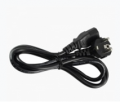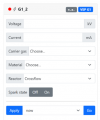VSP-C1 User Manual: Difference between revisions
| Line 50: | Line 50: | ||
<gallery> | <gallery> | ||
MainScreenC1 .png| Main screen C1 | |||
</gallery> | </gallery> | ||
Revision as of 09:48, 11 January 2023
This is the comprehensive User Manual for the VSParticle Controller (VSP-C1). The Quick Start Guide is available as a quick reference for standard operation of the VSP-C1 unit.
| Company | VSParticle B.V. | 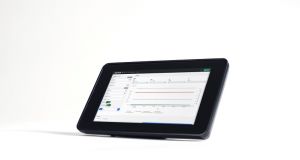 |
|---|---|---|
| Address | Molengraaffsingel 10 2629 JD Delft The Netherlands | |
| Website | vsparticle.com | |
| Support e-mail | support@vsparticle.com |
Introduction
The User Manual provides instructions for the set-up, operation, system care, and troubleshooting of a VSParticle C1 Controller (“VSP-C1”) unit.
If you have any questions or concerns regarding the VSP-C1 unit you have purchased or any information within the provided user documentation, please contact us via the contact details at the top of this page.
The VSP-C1 is designed for use by researchers who want to produce inorganic nanoparticles from conductive materials for applications in fields ranging from cluster research to materials science.
The VSP-C1 is designed for users who want to control experiments with the VSP-G1 and MFC+ to produce inorganic nanoparticles from conductive material for applications in fields ranging from cluster research to material science. The VSP-G1 (“Generator”) is a desktop spark generator that uses spark ablation technology to produce aerosol nanoparticles after a high voltage spark evaporates part of two metallic electrodes. The MFC+ (“mass flow controller”) is a desktop device that has a mass flow meter (i.e. the sensor) combined with control valve and feedback electronics between sensor and valve.
The VSP-C1 is designed to have a versatile control system with software that enables easy to use interface to control the experiment.
System description
What's in the box
Congratulations on your purchase of the VSP-C1! In the box you will find the following:
-
C1,
-
Power Supply
If there's anything missing or looks damaged, contact us immediately at support@vsparticle.com or using the contact details at the top of this page! A damaged power supply cable may temporarily be replaced by a similar cable, but ensure it has a functional protective earthing terminal.
Settings
Set-up the VSP-C1, VSP-G1, and MFC+
For the total set-up of these devices you need a flat surface sufficient enough to place the VSP-G1, VSP-C1, and MFC+ on.
VSP-C1 Place the VSP-C1 device on the surface. Plug the power supply into the VSP-C1 and into a power point. The VSP-C1 will automatically start-up ad shows the following interface:
-
Main screen C1
VSP-G1 Place the base unit on a flat surface, ensuring sufficient space around the sides and back of the unit for gas, power and communication connections. Do not connect the system to a power supply until everything has been properly assembled.
For a detailed set-up of the VSP-G1, you can visit the user manual.
MFC+
Starting the C1 for the first time
Follow the guidelines to setup and use the C1 for the first time.
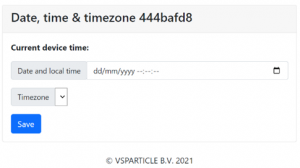
Start with setting the correct date, time, and time zone:
- Tap in the menu bar on Settings
- Select the Time & Date
- Set the correct date, time, and timezone
Connecting to C1 Network
For connecting your C1 to a network, click in the menu bar on Settings and select WIFI . Select your network network from the list. If it's not listed or requires additional configuration, please use this link to manually configure a network.
For manual configuration follow the next steps:
- Click on this link
- Enter your credentials of your preferred network.
- Fill in Network name
- Fill in Network security type
- Click on Connect
On the left, you can check the network status.
Connecting to C1 WIFI
For connecting your C1 to a WIFI, click in the menu bar on Settings and select WIFI . Select your WIFI network from the list. If it's not listed or requires additional configuration, please use this link to manually configure a network.
For manual configuration follow the next steps:
- Click on this link
- Enter your credentials of your preferred WIFI.
- Fill in Network name
- Fill in Network security type
- Click on Connect
On the left, you can check the WIFI status.
Remote Control With Laptop Via Network/WiFi
Connect laptop with your C1 via network/WiFi:
- Connect the C1 to the same WiFi as the laptop
- From the touchscreen: go to Settings > WiFi to discover the IPv4 address (usually looks like 10.X.X.X, 192.168.X.X, where X is a number between 0-255)
- From the laptop: go to the IPv4 address (e.g., http://192.168.X.X)
Remote Control With Laptop Via Hotspot
Create a hotspot with your C1, in case you prefer to not connect your C1 the a network.
Connecting to hotspot:
- From the touchscreen: go to Settings > Hotspot to discover the network name and password.
- From the laptop: connect to the C1 hotspot's WiFi information
- From the laptop: visit the address specified in the IPv4 to connect to the C1. This is always the same: http://192.168.4.1
Operating System
Setpoints & Scheduling
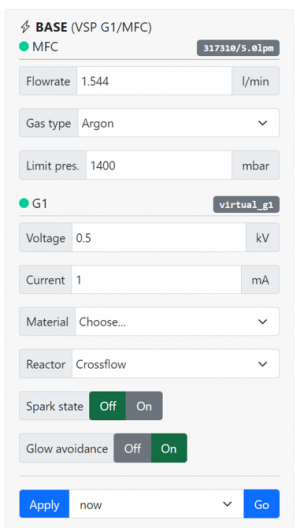
With the VSP-C1 you can directly control the supply of the VSP-G1 voltage and MFC+ flowrate. The two base elements are shown in the base module, as can be seen on the photo …. .
The setpoints can be filled in for the MFC+ and VSP-G1. For the MFC+, the flowrate in l/min, gas type, and limit pres. in mbar can be set. The VSP-G1 the voltage in kV, current in mA, material, reactor, spark state, and glow avoidance can be set. In the ‘Apply’ section you can schedule your experiment when you are finished with the filling in the setpoints. The options are between now, in such minutes, and at what time.
-
Apply now, in, or at,
-
Scheduled events
In the schedule events section, you can view your experiment settings, device, and setpoints.
Optional G1 or MFC+
It could be that you have chosen for multiple G1’s or MFC+ in the series. The extra setting will be shown in the software and with the option to customize the belonging setpoints. An example is shown in the figure … . This illustrates an extra G1 that is called G1_2.
-
Optional G1_2
Monitor Metrics
The Monitor Metrics section shows the values per setting. It provides an overview of the current value that is observed during the experiment.
The G1 & MFC graph shows the flow [l/min], flow setpoint [l/min], pressure [bar(a)], spark current [mA], spark current setpoint [mA], gap voltage [kV], and gap voltage setpoint [kV] for definite timeframe. This overview of the graph provides insight into these values during the experiment.
In the Scheduling C1 the timestamp, source, and message are noted in order to retrieve all control logs.
-
Monitor Metrics,
-
G1 & MFC graph,
-
Scheduling C1
Data management & Download
The data during the experiment is logged and therefore can be downloaded in the menu bar under “Data”. The following options can be found: download, disk space, disk clean-up. The download option allows you to select your data with a start and end date and download it in a csv. The disk space shows how much space is left in megabytes and percentage in the disk space. The last section is the disk clean-up where data can be manually removed from 10, 25, 50, or 100 days. You can also choose to rebuild the database. The deleted data cannot be recovered and will be lost after deletion.
Data download

To download the data from the C1 follow the following instructions:
- Tap in the menu bar on Settings
- Select the start and end time
- Click on Download to get the data in a CSV format
Disk space
To check for cleaned disk space, go to the Disk space in Data menu bar. Here you can check how much percent is used and check how many megabytes are left on the disk space.
Disk cleanup
It could be possible that you are not able to download your data. This might be caused by a full disk space. The following steps help you to delete data:
- Tap in the menu bar on Data
- Go to the section of Disk clean-up and click on Choose…
- The following option appear:
-
Delete data older than
- Choose your option and click on Execute
Shutting down
To shutdown the VSP-C1 system go the Power in the menu bar and click on Shutdown. The system will now successfully shutdown.
-
Power shutdown
To reboot the VSP-C1 system go the Power in the menu bar and click on Reboot. The system will now successfully reboot and the VSP-C1 will restart after sometime.
-
Power reboot
System care
The system requires no regular maintenance by the end user, but cleaning the reactor in the VSP-G1 periodically is recommended, especially after a change of electrode material. To prevent exposure to nanoparticles and to ensure safe and efficient cleaning, guidelines are set out in the operating and maintenance guide. The procedure to replace electrodes is also discussed there.
Troubleshooting
There are several possible issues that may arise during normal operation of the VSP-C1. The most common scenarios and errors are listed below.
When to contact VSParticle
- If the sytem does not respond, even after turning it on and off again
- If an error occurs that states to contact VSParticle
Remote support
For remote support you can connect VSParticle at support@vsparticle.com.
Errors & warnings
The errors and warnings can be found in the menu bar on the right.
The Alert button will be:

- Green when no error or warning occurs
- Red when an error occurs
- Yellow when a warning occurs
- Blue when an info message occurs


